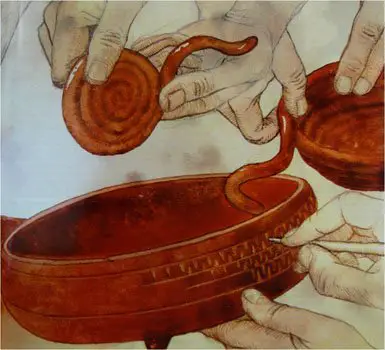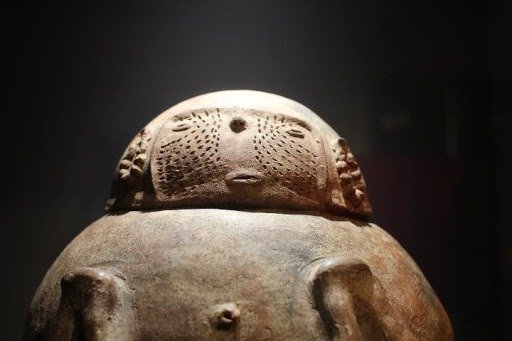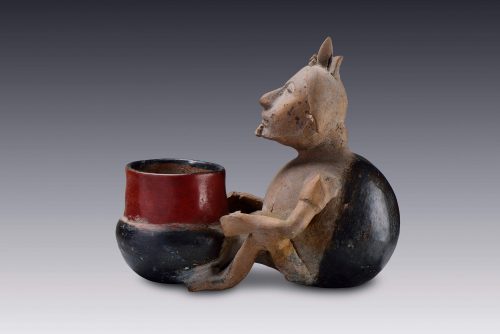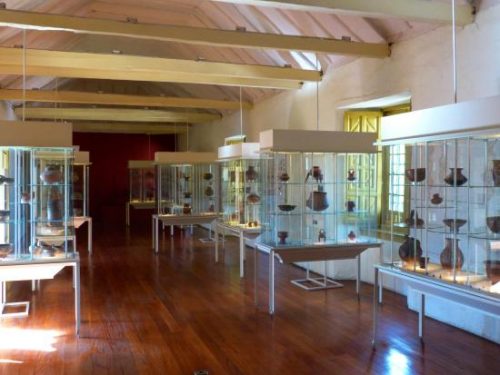Translated by Nick R
Did you know that ceramic art has marked the history of Latin America over time? It sounds a little strange, but, actually, pottery is a significant indicator of how the region’s cultures have developed.
With no potter’s wheel but very primitive kilns and the exhaustive search for raw materials to make clay, the pre-Columbian potters managed to make history in Latin America.
If you wish to learn all about pre-Columbian pottery: its history, its main characteristics, the most remarkable pieces created by Latin American peoples, and where you can go to see them nowadays, read on and you will surely learn a lot.
Table of Contents
What is pre-Columbian pottery?
Pre-Columbian pottery is the production of ceramics by various peoples of the American continent, particularly before European arrival on an exploration voyage at the end of the 15th century in 1492.
In Colombia, the main groups that dedicated to the production of ceramics were the Taironas, communities of Sinú, Nariño, Tierradentro, Quimbaya, Tolima, San Agustín, Tamalameque, Río de Miel, Tumaco, the Muisca and the Guane.
Other groups across the different regions were the Zapoteca, Chichimeca, and Toltec, located in Mesoamerica, where Mexico is located today. In Peru, the Mochica and Nazca stand out. And finally, two of the best-known pre-Columbian cultures: The Mayas and The Aztecs.
All, or most of them, were indigenous tribes who found ceramics of great help in storing and transporting their food and other products and for telling their history through figures and symbols made in this material.
Characteristics of pre-Columbian ceramics
The following are the features by which we can recognize pre-Columbian pottery.
- The pottery of the different pre-Columbian cultures is linked by various features such as its use in making ritual and ceremonial figures and also as decoration and utilitarian kitchen objects.
- Some of these pre-Columbian ceramic pieces are totemic depictions, that is, figures that people associate with beliefs or spiritual manifestations.
- Most of the figures were owls, caimans, snakes, monkeys, and lizards.
- The modeling technique they used was generally the spiral technique, which we know today as the coiling technique. It consisted of long clay strips that, when placed one on top of the other could form whatever piece they had in mind.
- The engraved pieces narrate through drawings the representative legends of those times, their daily life, their fauna, and their beliefs as a community.
- The female figure pieces were made thinking that women are a cult to the earth that gives fruits. That is why most of these pieces also included a baby in their arms.
- In the pre-Columbian period, pottery was so important that it was even present in burial rituals. This was seen in the burial urns, which were the vessels intended to keep the ashes of the deceased, and in the grave goods, which were objects placed on the bodies when in the tombs.
- The colors of paint used in pre-Columbian ceramics were black, red, cream, brown, ivory, and ocher.
- Eventually, the Muisca culture was the first to industrialize ceramics by using the gachas, a container for the commercialization of salt. Meanwhile, other groups continued to make pottery only for utilitarian and ritual use.
- A large part of the pre-Columbian vessels have tripods, which for them signified something special: the sky, the earth and the underworld.
- In order to create the vessels, sometimes they used everyday objects as molds. The baskets and fruits such as pumpkins would be covered with clay and then, during the firing process, they would disappear and only the vessel made with clay would remain.
- For firing the pieces, they used the oldest method, which was to place them under the sun. However, when the group knew how to make an open kiln, they burned their pieces in it.
- The decoration of pre-Columbian ceramics was very varied, using different techniques before and after firing the pieces. For example, they used impressions with everyday elements, incisions, and engobes.
One of the most renowned decorations in these pieces was the negative painting, which generated the characteristic bichromy of pre-Columbian ceramics. To do so, the design would be covered with wax or ash and then submerged in a bath of color. Then. the negative would appear clean after removing the protective layer.

History of pre-Columbian ceramics
Pre-Columbian pottery is born from the need of Latin American peoples to store, transport, and consume liquid and solid food; they required artifacts to help perform these basic tasks in their sedentary societies.
This pottery was made before the arrival of Europeans to America and different regions of Latin America were devoted to its production, such as Mesoamerica which includes several countries in Central America. Regions such as the Caribbean and the Andes also belonged to the pre-Columbian pottery makers.
Mesoamerica
In Mesoamerica, ceramic works from 2000 B.C. were found as vessels and figures representing everyday scenes, marriages, and games, and which were made exclusively to accompany the dead in their tombs. They were grave goods, fundamental and significant objects for them.
Mayan pieces decorated with hieroglyphic paintings, historical events, and mythological scenes were also found.
In the Caribbean and Central American region were found influences of the Mesoamerican and Colombian Andean creation and decoration in the following way: hieroglyphic style covering the vessels.
The Northern Andes
In the northern Andes of Colombia, Venezuela, Ecuador, and Peru are the two oldest places of pottery production on the continent, Valdivia and Puerto Hormiga.
There some of the most recognized and predominant features of pre-Columbian ceramics are born, such as the iridescent painting, the negative painting, pieces made with molds, the adoption of handles, and the production of whistling vessels.
The iridescent paint is easily distinguished in pieces such as bowls, plates, and bottles, because the only way to see the design was by placing them in direct sunlight or, more effectively, by immersing them in water.
The Mochica culture arose on the northern coast of Peru between 100 B.C. and 700 A.D. Their pieces had very unique traits, such as the bracket handle with a spout with depictions of scenes and modeled figures.
As with most of the scenes depicted in the pieces, the Mochica culture represented everyday life moments such as illness, eroticism, and war.
The most original art produced by the Incas was ceramics. Their pieces had different styles and techniques that enable us to study the evolution of the empire and the series of cultures that ended up forming the Inca culture.
In the Chavin culture and in the city of Paracas in Peru, ceramics had feline figures carved or painted on them. In Tiahuanaco, pottery was painted red or orange and usually had the shape of a footless cup. A serpent would coil around this cup and its head would extend beyond the top of the cup.
Nazca, a city in Peru, developed a delicate and slim ceramic. It was very polished and decorated with fruits and flowers.
Today, pottery continues to play a significant role in everyday life; however, not as important as it used to be, reflecting history and customs, but still present in certain towns that live from this art, for example, Ráquira, Boyacá in Colombia.
For artisan potters and non-mass producers practicing pottery is still an art and a way of expressing themselves that everyone should be familiar with at some point in their lives.
Main pieces of pre-Columbian pottery
There are many characteristic pieces of Pre-columbian pottery, but the main ones are utilitarian such as:
- Basins
- Pans
- Jugs
- Pitchers
- Vessels
- Cups
- Mucuras
And others that were very used in rituals as offerings or simple accompanying objects in these rituals, such as:
- Human figures
- Funeral urns
- Whistling vessels
Pieces used in domestic activities
In these pieces of different sizes, indigenous held elements such as water, corn, and salt. In addition, they could also ferment chicha and prepare and consume various foods.
Bowls
Bowls were used as food containers mostly. Regarding their shape, some were simply round bowls, while others had a tripod which, as we told you before, meant the sky, the earth, and the underworld for them.

Taken from: Catawiki
Pans
Pre-Columbian pans have left a great legacy in today’s ceramic pots. They still fulfill the same function they had years ago, which is to conserve heat for a long time, helping to cook food and keep it warm for hours.

Taken from: Men of clay
Jars
Jars were used to store and transport liquids like water. They took advantage of modeling by hand to create something more than a recipient and give significance to the object by creating shapes. Most of them were animals such as a chicken, a dog, or a turtle.

Taken from: Pinterest
Pitchers (Cántaro)
Vessels with almost the same function as pitchers, that of storing and transporting liquids, but with the difference that some can be more elongated and larger.

Taken from: Chilean Museum of Pre-Columbian Art
Vessels
When we talk about pre-Columbian vessels, we refer to all types of ceramic pieces that were used in the kitchen or to store food, such as bowls, pots, jars, and plates, which could have a pedestal like the one in the image.

Taken from: Pinterest
Goblets
The pre-Columbian goblets were not like today’s goblets. The recipient from which they drank was very large and deep, and its base was wide enough to grab it with both hands.

Taken from: Men of clay
Múcuras
Múcuras are containers similar to pitchers but medium-sized and with a long, narrow neck. They were also used to collect, drink and store water and other beverages such as the chicha.

Taken from: Boyacá 7 Días
Pieces used in rituals
There are 4 types of pieces that, in different ways, accompanied the rituals of these peoples.
Human or animal figures
These ceramic figures were made to depict different scenes of their daily life, and most of the time, they portrayed eroticism. In them, they could also show their physical constitution and the objects and clothes they wore at that time.

Burial urns
These objects were fairly used in the pre-Columbian period, as it was where the deceased’s ashes were placed. In addition, one must emphasize that it meant not only this but also a way to help them transition to a new state of the being as they thought of it.

Whistling vessels
These are unique musical instruments resulting from hundreds of years of acoustic and morphological experimentation. They consist of two united vessels that include a hidden whistle that operates by means of a hydraulic impulse. As the piece is moved and the water travels through both pots, a whistling sound is emitted by the hidden whistle in one of the two pots.
In this particular vessel, the whistle is located in a very small hole in the neck of the figure, as you can see in the image.


Where can you find these pieces?
MUSA Museum – Colombia
The House of the Marquis of San Jorge was built in Bogota at the end of the 17th century. For 48 years, its owner was Jorge Miguel Lozano de Peralta, and then it was donated by the Restrepo Saenz family to the Adorers nuns, who sold it after 27 years to Banco Popular, from where it was restored and turned into the current museum.
This museum offers guided tours and workshops that recreate pre-Columbian arts and crafts. In addition, it features 4 collections:
- Pre-Columbian ceramics
- Colonial art
- Religious art
- Pictorial expression art
The MUSA museum has two locations in Colombia, one in Bogota at Cra. 6 #7 – 43 and another in Cali at Cra. 4 #59. You can usually attend from 8:30 a.m. to 5 p.m. with an entrance fee of between 2,000 and 4,000 Colombian pesos.

Chilean Museum of Pre-Columbian Art
During the 1970s, Sergio Larraín García-Moreno started discussions with different companies to create a museum entirely dedicated to pre-Columbian art. In December 1981, under an agreement between the Foundation and the Municipality of Santiago, the Chilean Museum of Pre-Columbian Art opened its doors to the public.
This museum exhibits the earliest ceramics and textiles of the continent, as well as elaborates ritual and ornamental pieces. The exhibition depicts the cultural diversity and aesthetic richness of the pre-Columbian American peoples.
It is located in Santiago, Chile at 361 Bandera Street and the entrance fees normally are:
- For Chileans and residents of the country between 500 and 1,000 Chilean pesos.
- For foreigners: between 400 and 8,000 Chilean pesos.
The student entrance fee will always be the cheapest ticket price.

National Museum of Costa Rica
The foundation of the National Museum took place on May 4, 1887, under the presidency of Bernardo Soto. This museum was created with the purpose of providing Costa Rica with a public establishment to deposit, classify and study natural and artistic products.
From its first years, the museum has been oriented towards scientific research, education, exhibition, and the defense of the cultural and natural heritage. That is why it changes its exhibits over time to encourage learning.
The ceramic exhibition can be found in the Archaeological Collection of Ceramics.
These are the opening hours and entrance fees for the National Museum of Costa Rica:
- It opens from Tuesday to Saturday from 8:30 a.m. to 4:30 p.m. and on Sundays from 9:00 a.m. to 4:30 p.m.
- For residents over 12 years old, the entrance fee is 2,500 colones, and for foreigners, 11 colones.

With this recommendation of museums, we come to the end of this blog. We hope you have gained a lot of knowledge about the history of ceramics in Latin America through pre-Columbian pottery. If you want to learn more about it and see modeling and decoration techniques more closely, do not hesitate to visit the closest museum to you.
If you are interested in learning more about the history of ceramics, in our blog Ceramics Club, you can find more articles on this topic in countries such as Colombia, Greece, and the European continent.



